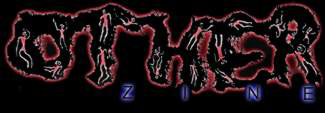
Message-in-a-Bottle Filmmaking:
An Interview with Thad Povey
by PEGGY NELSON
In early December I met with Thad in his basement studio in the Mission, where he works surrounded by film canisters, gadgets, tools, stills, magic markers, nail polish, scraps of material scavenged from everywhere, and loops of drying handpainted film in all stages of completion. Another program of his short films and collaborations will be featured at Other Cinema this spring.
Message-in-a-Bottle Handpainted Films Kid StuffThe Seventies Music Collaborations and Venues
Aargh-X, Wildman of Mystery The Leonardo Complex Rockets!
What did you start out doing in film?
I came up to San Francisco after school with my musician friends from Cal Poly, and was playing music a lot, but not playing out, just recording. We started making some Super-8 films. That was the first time I had made any films, and we were putting music to them. I realized filmmaking was perfect, you get to do all this stuff, and then you get to sit in the dark and watch other people watch it, and you don't have to be up in front of them.
 Then my friend Joe went off to NYU, and so I went to New York to hang out with him. I wasn't in school there, I was just hanging around and working on student films. The crowd I was in was all narrative. Then I came back to San Francisco and we made some films that were live action, surreal/narrative kind of things. That was '87, late eighties, when I first starting shooting film, and it was great and I certainly would have kept doing it, but I started running into different kinds of filmmakers in San Francisco. I took a class from Ted White, the classic Ted White, he taught a found footage class at FAF, same class that Craig Baldwin teaches occasionally and it was really great. Greta Snider was in the class, and those were the first found footage things that I had seen. I was interested, so that was the start of all rest of the non-narrative world for me. I continued making a few narrative musical kind of things, but they just became clumsy after awhile, those collaborations that become expectations. Where is a short-film career going to lead? It's much more fun to me just to do it and throw it out there, like message-in-a-bottle-type filmmaking. I'm just tossing films overboard and seeing what happens. Baling water, too.
Then my friend Joe went off to NYU, and so I went to New York to hang out with him. I wasn't in school there, I was just hanging around and working on student films. The crowd I was in was all narrative. Then I came back to San Francisco and we made some films that were live action, surreal/narrative kind of things. That was '87, late eighties, when I first starting shooting film, and it was great and I certainly would have kept doing it, but I started running into different kinds of filmmakers in San Francisco. I took a class from Ted White, the classic Ted White, he taught a found footage class at FAF, same class that Craig Baldwin teaches occasionally and it was really great. Greta Snider was in the class, and those were the first found footage things that I had seen. I was interested, so that was the start of all rest of the non-narrative world for me. I continued making a few narrative musical kind of things, but they just became clumsy after awhile, those collaborations that become expectations. Where is a short-film career going to lead? It's much more fun to me just to do it and throw it out there, like message-in-a-bottle-type filmmaking. I'm just tossing films overboard and seeing what happens. Baling water, too.
It was actually a monumental evening the night I showed my first film. It was the film that I made in that class. There was a film screening at the Adobe Bookstore, which is still there, on 16th, across the street from the Roxie. It was not a regular program, just a one-night thing, but there were a lot of people there, and I was totally freaked out, because I had finished this film and wasn't going to show anybody. It had one of these little collage-type sequences where I had cut together all this home movie stuff, and the only reason I cut it together was I noticed in this batch of home movies, the dad points the camera and says 'OK, walk towards the camera'. That was kind of his thing to do. And so I just cut these sequences back and forth between these two shots, in one shot it was a little girl dressed up for catechism or something, and in the other case it was a Mountie with a riding crop in his hand on a ski lift. The camera's going down on the ski lift and passing him, so you get this great back-and-forth between the little virginal thing and the authority figure. I didn't cut it with that in mind, I did it just because of the movement.
So anyway, the film's playing and I'm sitting there in the dark, and all of a sudden right after that sequence, I heard the guy next to me, who I didn't know, lean over to his girlfriend and say 'that was really cool', because he got into that whole authority dialectic of the thing. I wanted to just grab him and say, 'tell me more! Tell me why that worked!' It blew my mind that I could actually affect somebody like that. And to be sitting in the dark and not have to be performing to do it was really cool.
top
When did you start manipulating the film itself?
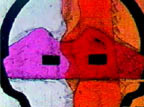 Well, manipulating came later. I was starting to hang around Al Alvarez a little bit, and was going to shows where hand-made films were featured. Hanging around 30 Berry Street and all those people down there was certainly a big part of that. Seeing some of Dean's films for the first time. Al and I sat and started manipulating film together some nights, and I realized how much fun it was and how long it can actually take to produce some material.
Well, manipulating came later. I was starting to hang around Al Alvarez a little bit, and was going to shows where hand-made films were featured. Hanging around 30 Berry Street and all those people down there was certainly a big part of that. Seeing some of Dean's films for the first time. Al and I sat and started manipulating film together some nights, and I realized how much fun it was and how long it can actually take to produce some material.
Did you get into the Zone?
Oh yeah. But I realized I wanted to have people to be in the Zone with. Because you could sit all night all alone and you'd come up with a little 3 foot strip of film, but if you have three people that means you have at least 9 feet of film, and conversation. It's like people might not have ever made quilts if they had to always do it alone, that's why there were quilting bees; this is definitely like a quilting bee.
It seemed to me like your process must be like embroidery, sewing, all those traditionally women's domestic crafts that take forever.
Yeah, it's definitely like that, and in fact all the Scratch Film Junkies currently are women. It's kind of like Charlie's Angels! But that's not intentional. Originally I asked two friends who were non-filmmakers who I thought were going to get into this with me because I was just learning it myself, and one guy, Chris, named us Scratch Film Junkies. He came to the first night and he never came back because he was doing other stuff, but he left us the name! Right now they're all non-filmmakers, there's an architect, a painter, a tagger...
So you're the only filmmaker in the Scratch Film Junkies?
Yeah, currently. It's kind of a rotating thing. One woman's in Brooklyn, a pen-pal junkie; when she's out here she joins in but otherwise she throws stuff in the mail. Together, it's really fun just to sometimes lay out a big loop of film and have everybody pass it around, but generally it's everybody working on their own idea. It's gotten to the point now where I'm starting to say OK, I'm getting an idea for a film, so let's start with the idea and then back up and do the techniques afterwards; but it's still more fun to just generate material and then figure out the film afterwards.
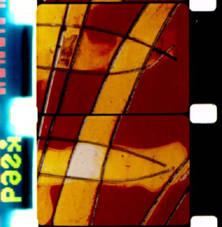 This is our fermenting tank (a rack of strips of handpainted films). Things come up here and they sit around for awhile, in fact a lot of these are ideas that are not going to go any further. And some of the prettiest ones aren't the ones that do as well, they're more or less opaque. This one is actually a mesh, you can buy it in little strips, and I cut it into 16mm width and then punched the holes in the edge so it became a piece of film. It didn't start as a piece of film. That's what's fun to do, to make film out of anything.
This is our fermenting tank (a rack of strips of handpainted films). Things come up here and they sit around for awhile, in fact a lot of these are ideas that are not going to go any further. And some of the prettiest ones aren't the ones that do as well, they're more or less opaque. This one is actually a mesh, you can buy it in little strips, and I cut it into 16mm width and then punched the holes in the edge so it became a piece of film. It didn't start as a piece of film. That's what's fun to do, to make film out of anything.
A few months ago I saw a little film by silt, which I think is called Ouroboros. They took a 6-foot long snakeskin, and they sandwiched it between 2 pieces of adhesive tape, cut it to 35mm width, punched the holes in it, and put it in a handcrank projector, so the head would go by, and the tail, and you'd watch the whole snake go by. Ouroboros, the snake swallowing its tail. silt is into burying things in the dirt, and letting them rot, and making their own emulsions with plant dye and stuff. I think of them as the organic junkies. Whereas we love those chemicals! Hence the name junkies, because by the end of the night you're like, 'wow, this nail polish remover stuff is great!' After you've been inhaling it for 3 hours. This (picking up a piece of film) is nail polish, I call these images 'micro-aeolian dispersal patterns'. You put fingernail polish on and blow it around with Dust-off as it dries. Let me hold this one up to the light. They look like little bugs there.
Living in their 2-dimensional little world.
What I do with all this stuff [hand-painted sequences] is slow it down by half so it runs at 12 frames a second essentially, so it's a little more watchable. Camera-less films can be really hard on the eye after awhile, just because they go so fast, so I like to slow it down 2 or 3 times.
 I tell my students that this is digital filmmaking, because these are your digits (wiggling fingers). Whenever somebody says, 'I'm making a digital feature', I think, 'digital feature? Man, that's a lot of painting!' They will totally not know what I'm talking about.
I tell my students that this is digital filmmaking, because these are your digits (wiggling fingers). Whenever somebody says, 'I'm making a digital feature', I think, 'digital feature? Man, that's a lot of painting!' They will totally not know what I'm talking about.
top
Actually my 3-year old daughter Isabel and I make these films too.
What does she do?
She sits there and draws with Sharpies on the film. We did one last week and at one point I cut some of her hair off and taped it down on the film and she was really excited about that.
And then when you project it does she know that it's hers?
Oh yeah, she'll say, 'that's the color I used...' I'd really like to take that idea to her class someday, and just get the whole class to do it. The only problem is you can't use watercolors on film, so they'd get Sharpie all over their hands, and it doesn't wash off for three days. The parents might have to sign something. What would be fun is to show it to the whole school, to the sixth-graders, so they can see that, wow, the littlest kids make films, and we're still gluing beans on paper?
top
When I saw your work at Other Cinema I was having these Randolph Mantooth flashbacks! It seems like you got a lot of your found footage from the 70s.
 Not TV shows, because I tend to avoid stuff that's too obvious in its source, but definitely the 70s, because that's when so much of this stuff is from (gesturing towards a wall of film reels). This is material that was scored from a local film company that got rid of all their vaults, and some friends of mine saved it all instead of throwing it all away, and when 30 Berry Street closed, they said they're not going to move this again, so I took it all. The company primarily did public service announcements for TV, but they were shot on the film stock that has the little sound-stripe on it, so what I have is a camera original, kodachrome or ektachrome, really beautiful colors, with the sync sound. A lot of times when you peel these old rolls apart the sound gets wrecked but there's usually some way to save some of it. This material's never been projected, so it hasn't been scratched, hasn't faded, and has barely been edited. That's what, in my world, is really really precious, really unique.
Not TV shows, because I tend to avoid stuff that's too obvious in its source, but definitely the 70s, because that's when so much of this stuff is from (gesturing towards a wall of film reels). This is material that was scored from a local film company that got rid of all their vaults, and some friends of mine saved it all instead of throwing it all away, and when 30 Berry Street closed, they said they're not going to move this again, so I took it all. The company primarily did public service announcements for TV, but they were shot on the film stock that has the little sound-stripe on it, so what I have is a camera original, kodachrome or ektachrome, really beautiful colors, with the sync sound. A lot of times when you peel these old rolls apart the sound gets wrecked but there's usually some way to save some of it. This material's never been projected, so it hasn't been scratched, hasn't faded, and has barely been edited. That's what, in my world, is really really precious, really unique.
And what's really great is it's all the outtakes, it's the stuff they didn't want, so you get all those awkward moments of people waiting for something to happen. Everybody's hung out to dry in some way, because the directors tend to just let the camera run for however long it takes until the film runs out. They basically would ask them the same question 40 times in a row. They would just let these people get more and more nervous, and rarely did the takes get any better.
So the first thing I did when I saw this roll of film from the Future Business Leaders of America Conference [that went into the film Thine Inward-Looking Eyes] was to cut out everything where their lips are moving, take everything in between all that stuff, and then I tried to structure it so that it was almost like a formal talk-show where there are no jump cuts, just continuity cuts. Rock Ross called it 'a talk show for the telepathic'. It's kind of sinister. 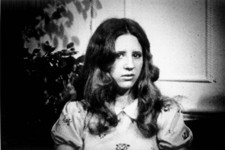 And the crowd shots in that film, that's the stuff for me that's exactly like me growing up, you know. Not slightly, not metaphorically, but exactly, because I was so nervous in high school all the time. I recognize a dozen people in that crowd, even though I don't know where it was filmed. I'd think, that's Kyle Hochstadter, and that's Diane somebody-or-other and they look exactly like those people, so it's a very personal film in the sense of the purgatory of being in high school in the 70s. That whole film took about 8 hours to make; it was the quickest thing I had ever done, and I really didn't change it except maybe add some sound and titles, and it's definitely been one of the better things I've made too, as far as audience response.
And the crowd shots in that film, that's the stuff for me that's exactly like me growing up, you know. Not slightly, not metaphorically, but exactly, because I was so nervous in high school all the time. I recognize a dozen people in that crowd, even though I don't know where it was filmed. I'd think, that's Kyle Hochstadter, and that's Diane somebody-or-other and they look exactly like those people, so it's a very personal film in the sense of the purgatory of being in high school in the 70s. That whole film took about 8 hours to make; it was the quickest thing I had ever done, and I really didn't change it except maybe add some sound and titles, and it's definitely been one of the better things I've made too, as far as audience response.
And it's now metamorphosed into Everybody Grab a Pardner, a project with musician Mark Growden which changes the tone so that it becomes burlesque. What's sort of this personal story becomes this big farce; it's really fun to see projects like that change and metamorphose.
top
It seems like music is a strong narrative thread in a lot of your work.
 Yeah, I'll listen to Tom Waits or somebody and think this would make a great film but at that point I'm only thinking of images that are based directly on his lyrics. But when I actually sit down and start doing it, it's more fun to totally stray away from the lyrics. Like with Pardner, which goes with the song Fuckboy, there's a direct reference but I'm not showing sex, I'm not going to use pornography in that film because it would be too obvious. Other films, like St. Louise, which is one of the Scratch Film Junkie films that goes with a Soul Coughing tune; it really has nothing to do with what the song is about. In one of the Aargh-X episodes there's a Ween song, with some fairly specific lyrical images. There's somebody described as a child without an eye, and you're seeing Aargh-X and you think OK, maybe this guy is like a child, and he is! What I really like is just sparsely connected things between the song and the pictures where, maybe they're supposed to connect but then it's off into some other realm. You're just given these little spins, like the lyrical spin. I think they're like magic acts: either you're blatantly being fooled here, or there's some subtle sleight-of-hand.
Yeah, I'll listen to Tom Waits or somebody and think this would make a great film but at that point I'm only thinking of images that are based directly on his lyrics. But when I actually sit down and start doing it, it's more fun to totally stray away from the lyrics. Like with Pardner, which goes with the song Fuckboy, there's a direct reference but I'm not showing sex, I'm not going to use pornography in that film because it would be too obvious. Other films, like St. Louise, which is one of the Scratch Film Junkie films that goes with a Soul Coughing tune; it really has nothing to do with what the song is about. In one of the Aargh-X episodes there's a Ween song, with some fairly specific lyrical images. There's somebody described as a child without an eye, and you're seeing Aargh-X and you think OK, maybe this guy is like a child, and he is! What I really like is just sparsely connected things between the song and the pictures where, maybe they're supposed to connect but then it's off into some other realm. You're just given these little spins, like the lyrical spin. I think they're like magic acts: either you're blatantly being fooled here, or there's some subtle sleight-of-hand.
My dad always played guitar and piano, he was a creative person, you know, as a hobby. In the 40s my dad played in a jazz band, Art Holman and the 10 Commanders, to work his way through college. I have a picture of him in the big band, with 3 girls in front of the big microphones, and my dad's in the corner with his little nylon string guitar.
I started playing guitar when I was 18 or 19. I was totally into Peter Gabriel, that kind of music, and I wanted to be a musician, so I was ready to drop out of school several times, but people would say, you know, just get your degree...College was pretty easy, it didn't take a lot, I could pass and get A's without that much trouble, and so I just played guitar all day long and drove my roommates crazy. They'd be at school, and I'd be at home, eating the food in the fridge and playing guitar. Then they'd come home and be like, 'you're still here?', and I'd say, 'yeah, listen, I've got Stairway to Heaven all worked out!' But finally I realized I do not have the temperament of a musician; mainly, I don't like to be in front of people. I pictured I'd just get to be a really good musician and I'll play in the studio all the time and I wouldn't have to play live, but you get to be good by playing live, and it dawned on me after awhile that hmmm, really this is not going to work. You can't sit in your bedroom all day playing guitar.
top
Tell me about your collaboration with Mark Growden.
I met him last January. He was playing this little kind of living room show, and my friend Lucio said you gotta come see him, and I was really into what he was playing. At the show he announced that he had a tour planned in the next week, he was leaving in 2 days to go through the Southwest, he's got all these dates planned, and um, oh, does anybody have a car? His stuff took up most of my car but there was enough room for a projector and a screen, so I packed a few films and along the way I started showing stuff with his music and seeing what fit. The film Everybody Grab a Pardner is the first thing from it. Mark's song is called Fuckboy, so I put the least sexy film that I had over the thing and it worked really well, and I definitely thought, OK, we got a few projects ahead of us. We've got a lot of good projects in mind.
So how many films have you made?
Only a couple of Aargh-X's films are done, but I think about 12 films maybe, plus collaborations, 3 or 4 more collaborative-kind of things.
Where do you show your stuff?
I've done all the little funky festivals, did Sundance once, but mostly it's all the little things like Golden Shower Film Festival or whatever, but you know, it's futile. I've gotten really burned out in the last year of sending 30 bucks to a film festival for entering and so I've sort of dropped off doing even that.
The most gratifying thing certainly is showing them here, locally. I've been doing a lot of these screenings with musicians lately, over the last year, with Mark and another band, Ramona the Pest. Showing with live music, I really like that. I like the speakeasy atmosphere, as opposed to cinema. With Mark, I've done a few shows at Cafe du Nord, it's definitely really nice. An intimate salon kind of environment where it's not all film. It's music and film and maybe some other stuff going on, and suddenly film seems to make so much more sense, it's part of the performing arts, you know? I do like the sanctum of the cinema, but it's really nice to be in this world of live music. Especially when you're not in California and people can smoke, and there's smoke up in the light coming from the projector. Film should always be shown in a smokey bar! You realize there's a beam coming out of the projector when there's smoke in the air.
 Small-scale cinemas are really fun, 30 Berry Street, which became the New Nothing, were both totally inspirational for me. You'd be there late at night and there'd be 5 people there and everybody's having a late night of it. There's always a community but also like 3 or 4 people who have absolutely no idea what they're getting into. And they might walk out going, oh my god, that was so cool. Dragging the innocent victims in, and seeing if they're going to stomp out or have their lives changed because you know, it happens, you get changed by some of those screenings sometimes. It would be nice to tour micro-cinemas or places like that every year, but ultimately for me I like to mix it in with a musician.
Small-scale cinemas are really fun, 30 Berry Street, which became the New Nothing, were both totally inspirational for me. You'd be there late at night and there'd be 5 people there and everybody's having a late night of it. There's always a community but also like 3 or 4 people who have absolutely no idea what they're getting into. And they might walk out going, oh my god, that was so cool. Dragging the innocent victims in, and seeing if they're going to stomp out or have their lives changed because you know, it happens, you get changed by some of those screenings sometimes. It would be nice to tour micro-cinemas or places like that every year, but ultimately for me I like to mix it in with a musician.
So then each projection is not a finished product but a creative act of its own.
Totally. And I need to learn to like the fact that musicians get to change their set lists every night. Usually I'm really specific with sound and synching the sound to the images. But when I work with Mark I don't ever lock the sound to the picture because I know he's going to play it at a different tempo, or he'll stop in the middle and make some witty comment, or whatever. You always have to look at it slightly differently every time. So that's breaking me out of my little box of the way I usually work. I realized, just let the film exist like a song, it's not permanent, it's tape-spliced, it can change for a year or whatever it takes until the music settles down.
top
You have a series of films about Aargh-X, Wildman of Mystery. Is he based on Ishi?
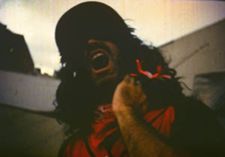 Yeah. There's a whole bunch of episodes, I'm now trying to map them out so I know where it's going. But it could be endless, it could be like Star Wars, I'll go back and do the prequel someday. The woman in it is based on Amelia Earhart. Her character is Ava, Ava Berliner. And the gist of the idea is: Ishi's origins are a mystery, and Ava's destination's a mystery, so what if they met briefly and had this little relationship of some sort?
Yeah. There's a whole bunch of episodes, I'm now trying to map them out so I know where it's going. But it could be endless, it could be like Star Wars, I'll go back and do the prequel someday. The woman in it is based on Amelia Earhart. Her character is Ava, Ava Berliner. And the gist of the idea is: Ishi's origins are a mystery, and Ava's destination's a mystery, so what if they met briefly and had this little relationship of some sort?
Definitely they've always been two of my favorites, because I grew up in Northern California, and that's where he came from. It started on a total fluke: putting my friend Keith in the caveman costume, shooting the snowman scene and afterwards, I started coming up with ideas. The Ava character is going to be essentially all found footage, so she doesn't really exist. Except that I might show her hands...it's mainly her camera P.O.V., because she's sort of a naturalist/adventurist.
Amelia Earhart was such a media creation herself.
Yeah, and you know what I just love reading about her how she was fairly genuine, but ends up seeing herself in a cigarette ad. I actually reshot Amelia Earhart's cigarette ad as something that's going to go in one of my little clips of Ava Berliner getting manipulated by her promoter. He funds her adventures, and in trade for that he gets to have a Sunday comic strip like Prince Valiant or Terry and the Pirates, and so every week, she sends back the little telegram and he turns it into a comic strip. But of course once she's out of the country, he can do anything he wants, so the comic strip goes right off into a heavy torrid romance, you know, she's a buxom babe and he's this guy like Fabio or Tarzan, and it's got very little to do with what's really happening.
Are you going to have somebody draw the comic strip?
My brother is a cartoonist, I've got the first one of these strips that he's done for me at home. And eventually of course with this Sunday cartoon the still images can become animated somehow and start taking on a film-life of their own.
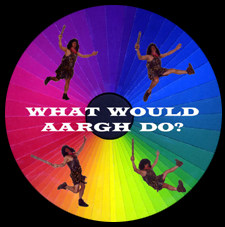 The big question in the film is, 'Is Aargh-X a hoax?' Obviously the person you're looking at on film is pretty funny, and I'm not asking him to be a great actor. Aargh-X is sort of an amnesia head case, he assumes he's real, that he really came out of the woods. That's the first thing he remembers, but everybody else is like, 'caveman???' It might be that this publisher planted this guy, you know, found a patsy, and put him up in the woods, and let Ava go find him, but the legend of Aargh-as-Missing-Link character is very real. There's levels of manipulation.
The big question in the film is, 'Is Aargh-X a hoax?' Obviously the person you're looking at on film is pretty funny, and I'm not asking him to be a great actor. Aargh-X is sort of an amnesia head case, he assumes he's real, that he really came out of the woods. That's the first thing he remembers, but everybody else is like, 'caveman???' It might be that this publisher planted this guy, you know, found a patsy, and put him up in the woods, and let Ava go find him, but the legend of Aargh-as-Missing-Link character is very real. There's levels of manipulation.
top
So did you want to be an artist when you were a kid?
Not really, it was not presented as an option when I was a kid.
What did you want to be?
The thing I used to do most is to make haunted houses and stuff like that. If somebody had said, you should be a production designer, I would have, but I didn't know what that was. I used to build really elaborate haunted houses, spend 3 months building my haunted house, I'd do blueprints and I'd redo the whole garage, get really into it. And I thought, maybe I'll work at Disneyland someday because they have a cool haunted house.
But my dad said, well you should be an engineer because I was into math too, so I got my BS degree from Cal Poly, and got an engineering license. For 15 years I've worked freelance doing engineering for architects: structural engineering, small-scale residential. I did it because I can work at home which gives you lots of time, and for filmmaking, that's what you need. But that's run its course, I'm just really burnt out on it, and 15 years or whatever, that's plenty. So I'm in this state of trying to figure out how to make money doing something else.
Anyway, I guess I have a sort of science-y background. My hero's always been Leonardo da Vinci; I want to do art and science. I came up with a good complex a while ago, a Leonardo Complex - which is not Di Caprio. No. A Leonardo Complex is like, if I'm not like da Vinci I'm failing.
It's a pretty high standard to hold yourself to!
It's stupid; plus, I don't have a king who's paying for my capital, and I don't have a studio full of little Leonardos working for me or whatever.
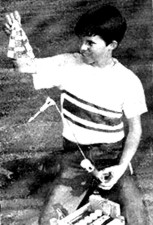 I got to go to his last house in France a year ago last summer, it was really cool. I'll be a fan. For this, you know, I can be a fan. There were models of all his things. That's really what I used to do as a kid most was stuff like that: draw little pictures of things like that and try to build them. I made these weird little things that worked, usually. For my Hotwheels set, we were having races, and I had to find a way to see who would win the race down those two tracks. I needed this gizmo because I was alone one day and starting both cars, and I couldn't run to the end of the track fast enough to see who won! So I made this double gate, a piece of wood with string and a bunch of little nails on it, and it had two flapping doors, and so when the first car triggered its door, it dropped a pin and locked the other door, so the loser car would just go 'smack'! And it worked, over and over, unless it was a photofinish and they'd both get smacked. I found it the other day in my mom's house. There were also ornithopter wings that I made of sheets, and sticks, and baling wire, literally baling wire, and I used to run up and down the backyard all afternoon trying to fly. Obviously time to move out of Red Bluff. My mom's still got them hanging in the shop.
I got to go to his last house in France a year ago last summer, it was really cool. I'll be a fan. For this, you know, I can be a fan. There were models of all his things. That's really what I used to do as a kid most was stuff like that: draw little pictures of things like that and try to build them. I made these weird little things that worked, usually. For my Hotwheels set, we were having races, and I had to find a way to see who would win the race down those two tracks. I needed this gizmo because I was alone one day and starting both cars, and I couldn't run to the end of the track fast enough to see who won! So I made this double gate, a piece of wood with string and a bunch of little nails on it, and it had two flapping doors, and so when the first car triggered its door, it dropped a pin and locked the other door, so the loser car would just go 'smack'! And it worked, over and over, unless it was a photofinish and they'd both get smacked. I found it the other day in my mom's house. There were also ornithopter wings that I made of sheets, and sticks, and baling wire, literally baling wire, and I used to run up and down the backyard all afternoon trying to fly. Obviously time to move out of Red Bluff. My mom's still got them hanging in the shop.
Did you ever try to jump off the garage?
No, I was kind of timid. It was as much a fantasy thing as anything because I'd get to the end of the yard and I'd close my eyes and stand there and go "whissssh, whisssssh", so it was as much about imagining flying as actually flying. Because later when my dad said, you know, you should take flying lessons, get your pilot's license, I was thinking - too technical!
top
Do you ever think about projecting your films on other things besides flat surfaces?
Yeah, actually I've been doing that more recently. I did a rocket ship in a bottle. My dad used to make ships in a bottle, and it dawned on me this year that I can do better! I put a rocket ship in a whiskey bottle, and I built a rear-projection screen inside the bottle which is a tissue-paper screen that you unfold in there, it fills up the bottle, and I project the Apollo 11 lift-off onto it. And I put it on this little stand that looks kind of like a gantry, you know, a rocket gantry, and there are actually some subtitles in it like, 'Flight: Man's Greatest Achievement' or something like that. I definitely want to do some more of it. I want to do all the great ships: a sunken ship in a bottle, a rocket ship in bottle, the Hindenburg, an airship in a bottle.
Did you make model airplanes when you were a kid?
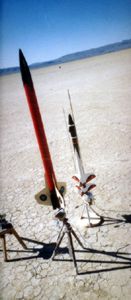 Yup. Well, actually, model rockets was the biggest thing for me, flying model rockets, which has become part of my filmmaking. I'm actually shooting film from a rocket now! This is called the Cineroc [bringing out a black cone-shaped little rocket], it's something I coveted when I was a kid, when I was building model rockets, I couldn't afford it because it was 25 bucks. They only made it for 4 or 5 years, in the early 70s, and my brother found it, where else?, on eBay. It's a Super-8 camera that sits at the top of another rocket. I built the rocket, it's about 2-3 feet tall, and the Cineroc has a little Super-8 cartridge which takes about 10 feet of film, about 28 seconds. It peeks out and bounces off this little mirror, so it's looking back down as you take off. You see the fins of the rocket, and since the rocket's a 2-stage rocket, you actually get to see the first piece separate and you get to see the parachute pop out. I took it out in the Black Rock Desert, and I got all my friends to lie on the ground like paper dolls around the rocket pad.
Yup. Well, actually, model rockets was the biggest thing for me, flying model rockets, which has become part of my filmmaking. I'm actually shooting film from a rocket now! This is called the Cineroc [bringing out a black cone-shaped little rocket], it's something I coveted when I was a kid, when I was building model rockets, I couldn't afford it because it was 25 bucks. They only made it for 4 or 5 years, in the early 70s, and my brother found it, where else?, on eBay. It's a Super-8 camera that sits at the top of another rocket. I built the rocket, it's about 2-3 feet tall, and the Cineroc has a little Super-8 cartridge which takes about 10 feet of film, about 28 seconds. It peeks out and bounces off this little mirror, so it's looking back down as you take off. You see the fins of the rocket, and since the rocket's a 2-stage rocket, you actually get to see the first piece separate and you get to see the parachute pop out. I took it out in the Black Rock Desert, and I got all my friends to lie on the ground like paper dolls around the rocket pad.
Just like what skydivers do except they were already on the ground!
Exactly! But I'd hate for anyone to have to risk their lives. I guess I want to become the Busby Berkeley of rocketry. Eventually I want to have a bunch of people with big banners, and smoke flares in their hands, so when the rocket launches everybody runs out from the center, and you'll get these patterns, and people running in big circles with flags.
Also what I want to do is lie on the ground right under the camera, with a little face shield, and then run the film backwards, because you'd come falling out of the sky from 1000 feet in the air right onto somebody's face. It would be a great way to do portraits!
top
(Peggy Nelson is a Bay Area painter who reviewed Thad Povey's show at Other Cinema for the previous issue of Otherzine.)